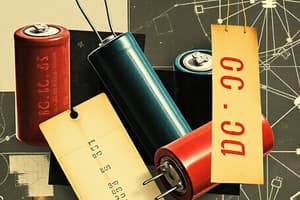Podcast
Questions and Answers
What is the primary function of a capacitor in electrical circuits?
What is the primary function of a capacitor in electrical circuits?
- To convert electrical energy into mechanical energy
- To enhance the flow of current
- To dissipate heat
- To store electrical energy (correct)
How does increasing the area of the plates in a capacitor affect capacitance, assuming constant spacing?
How does increasing the area of the plates in a capacitor affect capacitance, assuming constant spacing?
- Capacitance decreases
- Capacitance becomes zero
- Capacitance increases (correct)
- Capacitance remains the same
What happens to the net capacitance when capacitors are connected in series?
What happens to the net capacitance when capacitors are connected in series?
- The net capacitance is larger than any individual capacitor
- The net capacitance is smaller than that of any individual capacitor (correct)
- The net capacitance equals the sum of all capacitances
- The net capacitance is unaffected by the arrangement
Which of the following describes the standard unit of capacitance?
Which of the following describes the standard unit of capacitance?
What effect does moving the plates of a capacitor closer together have on capacitance, assuming constant mutual area?
What effect does moving the plates of a capacitor closer together have on capacitance, assuming constant mutual area?
When connecting capacitors in parallel, how is the net capacitance calculated?
When connecting capacitors in parallel, how is the net capacitance calculated?
What parameter is directly related to how much charge a capacitor can store?
What parameter is directly related to how much charge a capacitor can store?
Which of the following factors does NOT affect the capacitance of a capacitor?
Which of the following factors does NOT affect the capacitance of a capacitor?
Flashcards are hidden until you start studying
Study Notes
Capacitors
- Capacitors are electrical components that store energy.
- Capacitors are fundamental passive components like resistors and inductors.
- Capacitors are used for local energy storage, voltage spike suppression, and complex signal filtering.
- Capacitors store energy by distributing charged particles on plates to create a potential difference.
Capacitance
- Capacitance is the measure of a capacitor's ability to store an electrical charge.
- Capacitance is measured in farads (F).
- Factors affecting capacitance:
- Area of plates: Increasing the area of plates increases capacitance.
- Distance between plates: Decreasing the distance between plates increases capacitance.
- Dielectric constant of the material between the plates: A higher dielectric constant increases capacitance.
Series Capacitors
- Capacitors in series combine like resistances in parallel.
- The net capacitance in a series circuit is smaller than the individual capacitances.
- When calculating net capacitance in series, use the same units for all capacitors.
- Example: Two capacitors, C1 = 0.10 μF and C2 = 0.050 μF, in series have a net capacitance of 0.033 μF.
Parallel Capacitors
- Capacitors in parallel combine like resistances in series.
- The net capacitance in a parallel circuit is the sum of the individual capacitances.
- When calculating net capacitance in parallel, use the same units for all capacitors.
Studying That Suits You
Use AI to generate personalized quizzes and flashcards to suit your learning preferences.




